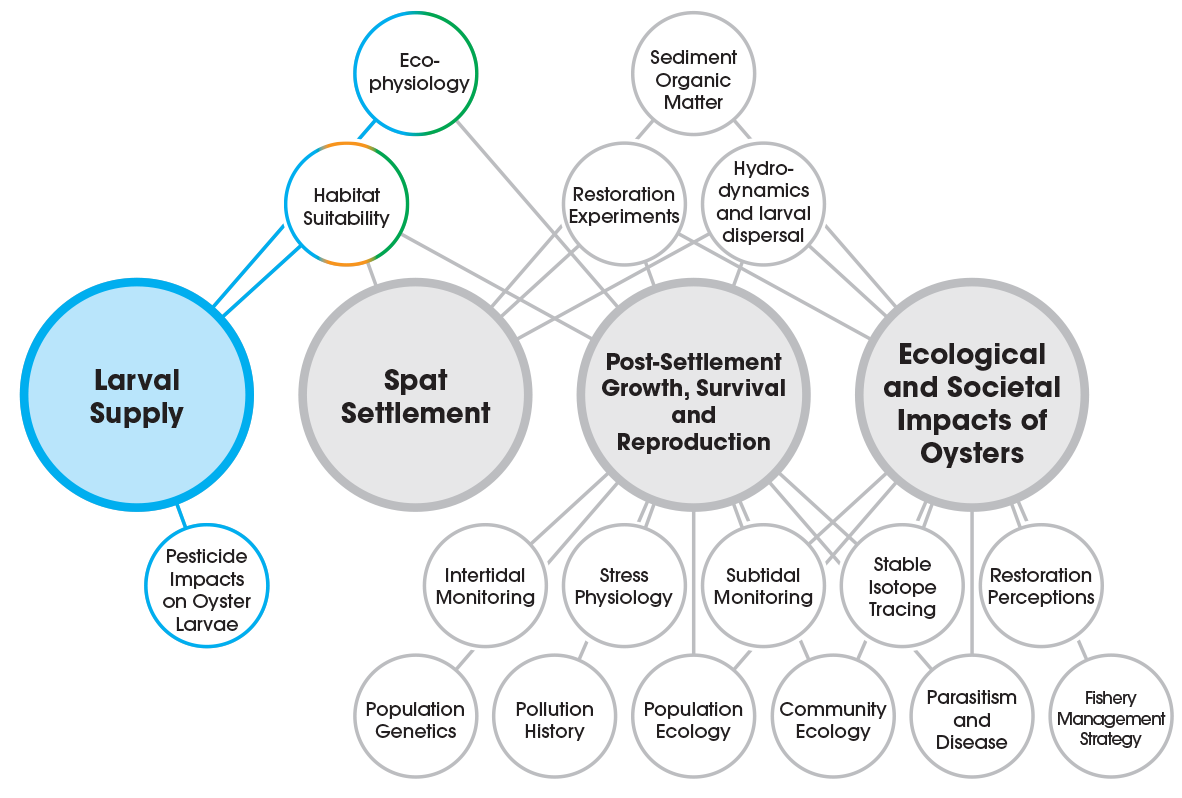What We Do
This interactive map lets you explore current ABSI research. Many of the questions we address in ABSI connect back to the oyster life cycle and the importance of oysters for the ecology of Apalachicola Bay and for the people that depend on the Bay.
As you can see, ABSI is pursuing a web of questions that all connect back to the foundational biology of oyster populations and their benefits for people and the Bay ecosystem.



- How do environmental regimes and hydrodynamics change with river discharge, and meteorological conditions?
- How do larval dispersal patterns change with river discharge, environmental regime, wind and current conditions?
- What are the best restoration areas within Apalachicola Bay based on the model predictions of optimal environmental conditions and larval distribution?
- Which areas are currently most likely to support oyster recruitment, growth and survival?
- How will these areas change under future climate scenarios?
- What substrate types are most conducive to oyster population development?
- How do seasonal environmental regimes affect habitat suitability patterns?
- How do seasonal variations in larval dispersal impact habitat suitability patterns?
- Is population connectivity an important variable for habitat suitability?
- Which areas within Apalachicola would be optimal for sanctuary (protected) reefs?
- How durable is oyster shell in benthic sediments of varying organic matter content?
- To what extent does increased benthic organic matter in Apalachicola Bay a) reflect a decline in oysters filtering and focusing organic matter deposition on reefs, and b) indicate a mechanism for decreased durability of shell substrate?
- What are the current and historical levels of pesticides in Apalchicola Bay sediments
- Do historical changes in pollutants reflect changes in oyster harvesting?
- Is the Apalachicola River a source of heavy metals and pesticides?
- What are the optimal conditions in temperature and salinity for larval development, growth rates, and survival?
- How does suboptimal conditions affect larval development, growth rates, and survival?
- What are the physiological tolerances of sub-adult and adult oysters to salinity and temperature, both separately and in tandem?
- What are the consequences of sublethal temperature and salinity stress to the physiological performance of oysters, including effects on survival, growth, and energetics?
- How will suboptimal environmental conditions impact critical metabolic processes, such as growth, reproduction, and osmoregulation, and energetic allocation?
- Do suboptimal salinity regimes inhibit inducible shell defenses of juvenile oysters?
- Is filtration rate (energy acquisition) of juvenile oysters reduced in suboptimal salinity regimes?
- Are energetic budgets of juvenile oysters altered by suboptimal salinity regimes?
- What are the most comment pesticides used in the Apalachicola-Chattahoochee-Flint watershed?
- What are the levels of these pesticides in the waters of Apalachicola Bay?
- How do different levels of target pesticides impact larval and juvenile oysters?
- How do reproductive cycles differ between inter-tidal and sub-tidal populations?
- How does spat settlement vary across space and time within Apalachicola Bay?
- How do biotic and abiotic factors affect oyster recruitment, survival and growth rates?
- How do growth rates vary across time and space within Apalachicola Bay?
- Does survival and/or growth vary between subtidal and intertidal environments?
- Are there spatiotemporal variations in oyster density, size, condition and disease?
- What are the lethal and sublethal effects of Dermo disease on Apalachicola oysters?
- How will changes in temperature and salinity alter the spread and impacts of disease?
- How will disease-driven reductions in oyster populations, and disease-driven changes to oyster traits like suspension feeding, impact the bay ecosystem?
- Are oysters effective “disease-diluters” by filtering out parasites and pathogens before they can infect other organisms?
- To what extent is disease impeding the recovery of the fishery?
- What is the population genetic structure of oysters in Apalachicola Bay?
- Are populations in the Bay more genetically similar (more well connected genetically) to populations east of the Bay or west of the Bay?
- Is there more than one genetic strain of oysters present in the Bay?
- Which populations outside the Bay would be the most genetically similar to provide a source for restoration efforts?
- Are there any physiological differences between hatchery raised and wild raised bay scallops? What about survival and growth?
- What is the optimal release size for hatchery raised scallops to be used in restoration aquaculture?
- Do bay scallops aggregate during spawning season?
- How do environmental conditions across the bay influence the growth and survival of oyster populations and their associated fauna, including oyster predators?
- What is the best cultch material and optimal configuration to maximize oyster reef community development?
- How does the presence of healthy oyster reefs shape the fish and invertebrate communities found in the bay?
- What role do oysters play in redirecting energy and nutrients through the Apalachicola Bay food web?
- What other important fishery species to oysters in Apalachicola help support and how has the decline of oysters impacted these fisheries?
- What primary producers fuel secondary production, including oysters in the bay?
- Have the sources of organic matter input fueling secondary production changed over decadal scales?
- Has the source and supply of organic matter input changed over decadal scales?
- Has the diminishment of the oyster population and their subsequent effects of filtering the water column affected input of organic matter to the bay's sediments?
- What is the optimal material size and type, reef height and configuration, and location for oyster recruitment, growth and survival?
- How does the recruitment and survival of oyster populations on different reef structures change over time and space?
- Are there any detectable patterns in spat settlement dependent on oyster density and size distribution?
- Does deploying hatchery raised spat on shell among artificial reefs enhance overall recruitment?
- Will small scale restoration experiments positively influence large-scale restoration efforts and management decisions over time?
- How can we apply remote sensing (drones) to long-term intertidal oyster monitoring?
- Do intertidal oyster populations show predictable temporal and spatial distribution? If so, what factors are driving these patterns?
- How will the expansion of mangroves into saltmarsh areas affect intertidal habitats?
- Are there any spatial patterns in subtidal oyster density and size distribution?
- What is the status of oyster habitat condition and type across the Bay?
- How are oyster populations changing over time in response to restoration activities?
- What is the current distribution of oyster populations within Apalachicola Bay and how does this impact species and trophic interactions?
- How does the decline in the oyster population influence/affect the fish distribution along the bay?
- How can we use all sources of data available (e.g., catch data, life history information) and oyster fishermen's knowledge to develop better models to inform fisheries policy and management decisions for oysters in Apalachicola Bay?
- How can Apalachicola Bay oysters be sustainably harvested to maximize the harvest while minimizing the chances of another fishery collapse?
- How do users of the Bay feel that oysters contribute to the Bay outside of the money from the fishery?
- How do different people who use the Bay define success for oyster restoration?
- What are the perceptions of users of the Bay about the historical success and then decline of the oysters in the Bay?
Large circles on the map:
The three main portions of the oyster life cycle, as well as the ecological and societal impacts of oysters, are represented by the large circles in the middle of this map. Hover your cursor over each large circle to highlight the projects that are addressing that specific research area.
Small circles on the map:
Each research project is represented by a small circle. Hover your cursor over a research project to see how it connects back to the oyster life cycle and the impacts of oysters. Click on a research project to open a research highlight box that describes the team that is pursuing a project and the questions the team addresses.

